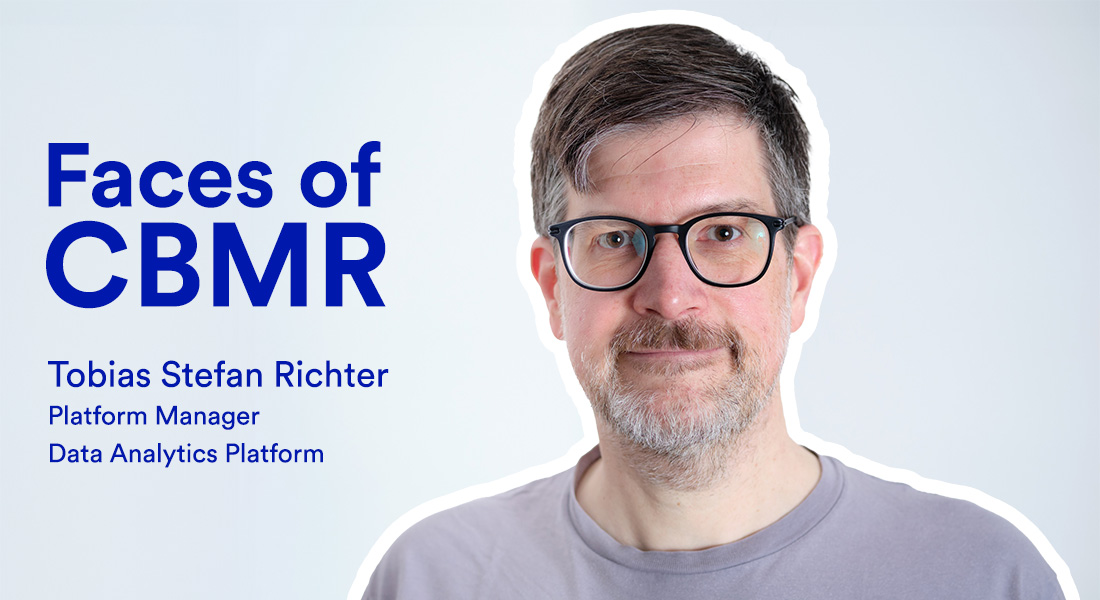“Most people who end up in a role like this enjoy building something meaningful for others”
Tobias Richter is Platform Lead of the new Data Analytics Platform, which will collect all data produced by research groups at CBMR. Tobias has extensive expertise in data acquisition and team leadership. We talked to him about bridging scientific research and data governance, leading a team, and his new position.

How did your interest in science start?
I guess it started back in my early school days. I was interested in chemistry, physics, and math. I wanted to find out how nature works and how, essentially, everything functions.
Take us through your academic and professional career until now.
I did my bachelor’s, master’s, and PhD at the Technical University of Berlin, all in atomic physics. After university, I became a data acquisition scientist for Diamond Light Source, a synchrotron facility in the UK. I was responsible for working out how to perform different experiments and how to format the data. After seven years, I joined the European Spallation Source, a similar facility, as a group leader in data acquisition.
What made you switch from atomic physics to data acquisition?
The shift happened mainly during my PhD. We had a lot of labor-intensive tasks, so I automated some processes to make it easier. I ended up partially improving results because the algorithms made everything more reliable. I shared my data with colleagues and gave them the logbooks so they could double-check everything. I probably spent more time automating things than I did writing my PhD thesis. I began thinking that if I liked this so much, then maybe I needed to find a job where I could help scientists figure out what kind of data they needed and how they wanted to use it.
How did you get into leadership?
It was kind of a natural progression from optimizing my own experiments to helping others do the same. If you want to make a bigger impact, you need to work with more people. And while I was enjoying doing hands-on programming, I could recruit people that were much better at programming than me. What I could provide was the translation between understanding the scientists’ needs and what the programmers could do. I can bridge that and provide a good service for people with a team much better than if I did all the work myself.
What excites you about leading teams?
Having a team enjoying what they’re doing while working to help other people is very satisfying to me. I think most people who end up in a role like this enjoy building something meaningful for others. That sort of thing generates a buzz for the whole team.
How did you come to work at CBMR?
It’s funny because I considered not applying, initially. I was looking for a change, and I saw the job ad – data analytics and people manager, that sounded perfect for me! Then I saw it was in health science, where I had no direct experience, so I was ready to scroll past. But I still read the whole thing, and I got more and more excited, but I didn’t think I would get invited for an interview. I was quite surprised at how quickly they got back to me after I applied. So yeah, I have definitely made a change, and now I get to learn a lot of new things in health science.
What does it entail to be Platform Lead for the new Data Analytics Platform at CBMR?
The new platform will help the center come together and promote collaborations between research groups by providing a sort of central support hub of data. We will help with the governance of data across the center, provide coherence, and standardize some processes. This will all help make things smoother for the research groups at CBMR. My role here is to support the team with the implementation and management. I started very recently, so I’m still familiarizing myself with everything. The setting and the subjects are new to me, but it’s still all about learning the needs of the scientists, working with data, and leading a team.
What is your go-to approach to starting a new job?
For me, a lot of it comes down to talking to people. You need to build up relationships, explain what you are about, and work at understanding how to solve the things you are hired to solve together.
This interview was edited for clarity and concision.
